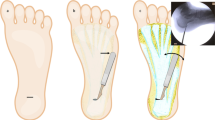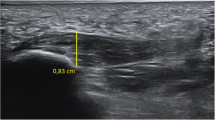Summary
Purpose
The purpose of the present study is to present the surgical technique, and to review our indications and results after endoscopic release in plantar fasciitis.
Material and methods
In 5 embalmed human specimen a biportal technique for endoscopic release of the plantar fascie was established. The purpose was to evaluate the relation between the plantar fascie and the heel spur. Afterwards we tried to release only 50–70% of the plantar fascie from the calcaneus. During a period of 5 years, this surgical technique was performed in 10 male and 7 female patients with the clinical entity of plantar fasciitis. The average age was 35 years (24–56 years). All patients underwent conservative treatment for at least 6 months.
Results
In the first 5 patients, surgery was performed under c-arm control. In all patients the operation could be completed endoscopically. The endoscopic protals healed without complications. The time for surgery during the learning curve ranged between 21 and 74 minutes (average: 41 minutes) and was still longer compared to the open technique. The clinical follow-up ranged between 4 and 48 months (average: 18.5 months). Of the 17 patients, 13 improved clinically and they would choose the treatment option again. In the Ogilvie-Harris score, 7 patients showed good and 6 excellent results. In 2 patients, the initial results were not satisfactory, caused by a bony stress reaction of the calcaneus. This complication was treated by 6 weeks of partial weight bearing without any further problems. Two other patients developed secondary pain in the lateral column. In spite of the minimally invasive approach, it seems to be important to increase the weight bearing in early rehabilitation carefully.
Conclusion
Endoscopic release of the plantar fascie (ERPF) is a standardized and reproducable procedure. The midterm results are promising. A loss of plantar stability should be kept in mind and has to be avoided.
Zusammenfassung
Fragestellung
Ziel der vorliegenden Untersuchung ist es, die Indikation, OP-Technik sowie die Ergebnisse des endoskopischen Releases der Plantarfaszie darzustellen.
Material und Methode
An 5 nicht fixierten Präparaten wurde eine biportale Technik zum endoskopischen Release der Plantarfaszie erprobt. Ziel war es hierbei zum einen, die Relation zwischen Plantarfaszie und plantarem Fersensporn zu evaluieren; zum anderen wurde eine Technik erprobt, bei welcher nur 50–70% der medialen Plantarfaszie vom Kalkaneus abgelöst wurde.
Über einen Zeitraum von 5 Jahren wurde diese Technik bei 10 männlichen und 7 weiblichen Patienten mit dem klinischen Bild einer Plantarfasziitis durchgeführt. Das mittlere Alter der Patienten betrug 35 Jahre (24–56 Jahre). Alle Patienten durchliefen zunächst konservative Therapieversuche von zumindest 6 Monaten.
Ergebnisse
Bei den ersten 5 Patienten wurde der Eingriff unter Bildwandlerkontrolle durchgeführt; bei den weiteren Patienten erfolgte die Resektion ohne intraoperative BV-Kontrolle. Bei allen Patienten konnte der Eingriff wie geplant durchgeführt werden. Die endoskopischen Portale heilten ohne Probleme. Die OP-Zeit ist im Rahmen der Lernkurve mit Zeiten zwischen 21 und 74 Minuten (MW: 41 Minuten) noch länger als in der offenen Technik. Der Nachuntersuchungszeitraum betrug zwischen 4 und 48 Monate (MW: 18,5 Monate). Bei 13 der 17 Patienten kam es zu einer klinischen Verbesserung und sie würden den Eingriff erneut durchführen lassen. 7 Patienten zeigten ein gutes und 6 ein sehr gutes Ergebnis im Ogilvie-Harris-Score. Bei 2 Patienten war das initiale Ergebnis nicht zufriedenstellend. Die Ursache hier lag in einer ossären Übermüdungsreaktion des Kalkaneus. Diese Komplikation wurde durch Entlastung über 6 Wochen symptomastisch behandelt. Bei zwei weiteren Patienten stellten sich sekundäre Überlastungen am lateralen Fußrand ein. Im Rahmen der frühen Rehabilitationsphase war es wichtig, trotz des minimalinvasiven Vorgehens, eine vorsichtige Belastungssteigerung durchzuführen.
Schlussfolgerung
Die Technik des endoskopischen Releases der Plantarfaszie (ERPF) ist standardisiert und reproduzierbar durchführbar. Sie führt zu guten mittelfristigen Ergebnissen. Ein Stabilitätsverlust der plantaren Verspannung sollte jedoch unbedingt vermieden werden.
Similar content being viewed by others
References
Acevedo JI, Beskin JL (1998) Complications of plantar fascia rupture associated with corticosteroid injection. Foot Ankle Int 19:91–97
Arangio GA, Chen C, Kim W (1997) Effect of cutting the plantar fascia on mechanical properties of the foot. Clin Orthop 339:227–231
Barrett SL, Day SV, Pignetti TT, Robinson LB (1995) Endoscopic plantar fasciotomy: a multi-surgeon prospective analysis of 652 cases. J Foot Ankle Surg 34:400–406
Barrett SL, Day SV (1991) Endoscopic plantar fasciotomy for chronic plantar fasciitis/heel spur syndrome: surgical technique—early clinical results. J Foot Surg 30:568–570
Basford JR, Malanga GA, Krause DA, Harmsen WS (1998) A randomized controlled evaluation of low-intensity laser therapy: plantar fasciitis. Arch Phys Med Rehabil 79:249–254
Batt ME, Tanji JL, Skattum N (1996) Plantar fasciitis: a prospective randomized clinical trial of the tension night splint. Clin J Sport Med 6:158–162
Bedi HS, Love BR (1998) Differences in impulse distribution in patients with plantar fasciitis. Foot Ankle Int 19:153–156
Brekke MK, Green DR (1998) Retrospective analysis of minimal-incision, endoscopic, and open procedures for heel spur syndrome. J Am Podiatr Med Assoc 88:64–72
Brugh AM, Fallat LM, Savoy-Moore RT (2002) Lateral column symptomatology following plantar fascial release: a prospective study. J Foot Ankle Surg 41(6):365–371
Cardinal E, Chhem RK, Beauregard CG, Aubin B, Pelletier M (1996) Plantar fasciitis: sonographic evaluation. Radiology 201:257–259
Chandler TJ (1998) Iontophoresis of 0.4% dexamethasone for plantar fasciitis. Clin J Sport Med 8(1):68
Chandler TJ, Kibler WB (1993) A biomechanical approach to the prevention, treatment and rehabilitation of plantar fasciitis. Sports Med 15:344–352
Daly PJ, Kitaoka HB, Chao EY (1992) Plantar fasciotomy for intractable plantar fasciitis: clinical results and biomechanical evaluation. Foot Ankle 13:188–195
de Souza H, Reed L (1997) An inexpensive „orthosis“ for plantar fasciitis. Med J Aust 167:509
Gill LH, Kiebzak GM (1996) Outcome of nonsurgical treatment for plantar fasciitis. Foot Ankle Int 17:527–532
Graves RH 3rd, Levin DR, Giacopelli J, White PR, Russell RD (1994) Fluoroscopy-assisted plantar fasciotomy and calcaneal exostectomy: a retrospective study and comparison of surgical techniques. J Foot Ankle Surg 33:475–481
Hawkins BJ, Langermen RJ Jr, Gibbons T, Calhoun JH (1995) An anatomic analysis of endoscopic plantar fascia release. Foot Ankle Int 16:552–558
Heller KD (1999) Extracorporeal shockwave therapy in heel spur—analysis of the literature. Z Orthop Ihre Grenzgeb 137(2):13–15
Kane D, Greaney T, Bresnihan B, Gibney R, FitzGerald O (1998) Ultrasound guided injection of recalcitrant plantar fasciitis. Ann Rheum Dis 57:383–384
Kibler WB, Goldberg C, Chandler TJ (1991) Functional biomechanical deficits in running athletes with plantar fasciitis. Am J Sports Med 19:66–71
Kier R (1994) Magnetic resonance imaging of plantar fasciitis and other causes of heel pain. Magn Reson Imaging Clin N Am 2:97–107
Kinley S, Frascone S, Calderone D, Wertheimer SJ, Squire MA, Wiseman FA (1993) Endoscopic plantar fasciotomy versus traditional heel spur surgery: a prospective study. J Foot Ankle Surg 32:595–603
Krischek O, Rompe JD, Herbsthofer B, Nafe B (1998) Symptomatic low-energy shockwave therapy in heel pain and radiologically detected plantar heel spur. Z Orthop 136:169–174
Maier M, Durr HR, Kohler S, Staupendahl D, Pfahler M, Refior HJ, Meier M (2000) Analgesic effect of low energy extracorporeal shock waves in tendinosis calcarea, epicondylitis humeri radialis and plantar fasciitis. Z Orthop Ihre Grenzgeb 138(1):34–38
Manoli A 2nd, Harper MC, Fitzgibbons TC, McKernan DJ (1992) Calcaneal fracture after cortical bone removal. Foot Ankle 13(9):523–525
Mizel MS, Marymont JV, Trepman E (1996) Treatment of plantar fasciitis with a night splint and shoe modification consisting of a steel shank and anterior rocker bottom. Foot Ankle Int 17:732–735
Murphy GA, Pneumaticos SG, Kamaric E, Noble PC, Trevino SG, Baxter DE (1998) Biomechanical consequences of sequential plantar fascia release. Foot Ankle Int 19:149–152
Powell M, Post WR, Keener J, Wearden S (1998) Effective treatment of chronic plantar fasciitis with dorsiflexion night splints: a crossover prospective randomized outcome study. Foot Ankle Int 19:10–18
Reeve F, Laughlin RT, Wright DG (1997) Endoscopic plantar fascia release: a cross-sectional anatomic study. Foot Ankle Int 18(7):398–401
Sadat-Ali M (1998) Plantar fasciitis/calcaneal spur among security forces personnel. Mil Med 163:56–57
Sammarco GJ, Helfrey RB (1996) Surgical treatment of recalcitrant plantar fasciitis. Foot Ankle Int 17:520–526
Sammarco GJ, Idusuyi OB (1998) Stress fracture of the base of the third metatarsal after an endoscopic plantar fasciotomy: a case report. Foot Ankle Int 19:157–159
Sellman JR (1994) Plantar fascia rupture associated with corticosteroid injection. Foot Ankle Int 15:376–381
Smith WK, Noriega JA, Smith WK Jr (2001) Resection of a plantar calcaneal spur using the holmium:yttrium-aluminum-garnet (Ho:YAG) laser. J Am Podiatr Med Assoc 91(3):142–146
Sollitto RJ, Plotkin EL, Klein PG, Mullin P (1997) Early clinical results of the use of radiofrequency lesioning in the treatment of plantar fasciitis. J Foot Ankle Surg 36:215–219
Thordarson DB, Kumar PJ, Hedman TP, Ebramzadeh E (1997) Effect of partial versus complete plantar fasciotomy on the windlass mechanism. Foot Ankle Int 18:16–20
Tomczak RL, Haverstock BD (1995) A retrospective comparison of endoscopic plantar fasciotomy to open plantar fasciotomy with heel spur resection for chronic plantar fasciitis/heel spur syndrome. J Foot Ankle Surg 34:305–311
Tudor GR, Finlay D, Allen MJ, Belton I (1997) The role of bone scintigraphy and plain radiography in intractable plantar fasciitis. Nucl Med Commun 18(9):853–856
Wall JR, Harkness MA, Crawford A (1993) Ultrasound diagnosis of plantar fasciitis. Foot Ankle 14:465–470
White AD (1997) An inexpensive “orthosis” for plantar fasciitis. Med J Aust 166:616
Vohra PK, Giorgini RJ, Sobel E, Japour CJ, Villalba MA, Rostkowski T (1999) Long-term follow-up of heel spur surgery. A 10-year retrospective study. J Am Podiatr Med Assoc 89(2):81–88
Wolgin M, Cook C, Graham C, Mauldin D (1994) Conservative treatment of plantar heel pain: long-term follow-up. Foot Ankle Int 15:97–102
Author information
Authors and Affiliations
Corresponding author
Rights and permissions
About this article
Cite this article
Jerosch, J., Schunck, J., Liebsch, D. et al. Indikation, OP-Technik und Ergebnisse des endoskopischen Releases der Plantarfaszie (ERPF). FussSprung 2, 199–206 (2004). https://doi.org/10.1007/s10302-004-0063-y
Received:
Accepted:
Issue Date:
DOI: https://doi.org/10.1007/s10302-004-0063-y




